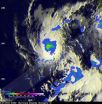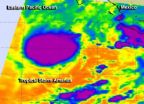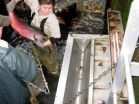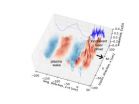(Press-News.org) Hurricane Amanda has weakened to a tropical storm, but not before NASA's TRMM satellite took a look under its clouds at the rate of heavy rainfall it was generating. After weakening to a tropical storm, NASA's Aqua satellite identified that those strong thunderstorms were limited to the area around the center of its circulation.
The Tropical Rainfall Measuring Mission satellite known as TRMM passed over Amanda on Saturday May 24, 2014 at 2150 UTC (5:50 p.m. EDT). TRMM is a joint mission between NASA and the Japan Aerospace Exploration Agency known as JAXA.
At NASA's Goddard Space Flight Center in Greenbelt, Maryland, rainfall data from TRMM's Microwave Imager (TMI) and Precipitation Radar (PR) instruments were overlaid on a GOES-15 visible/infrared image received at 2200 UTC (6 p.m. EDT). That was about six hours after Amanda was upgraded to a hurricane. At that time, Amanda had winds of about 70 knots (80.5 mph). TRMM's Precipitation Radar (PR) instrument had an excellent view of the rain falling at a rate of over 147 mm (about 5.8 inches) per hour in the northwestern side of the Amanda's eye wall. Intense storms in that area were reaching heights of over 16.3 km (about 10.1 miles).
The TRMM satellite had two other good views of Hurricane Amanda: on Sunday, May 25 at 2054 UTC (4:54 p.m. EDT) and on Tuesday, May 27 at 1049 UTC (6:49 a.m. EDT).
On May 25, Hurricane Amanda had winds speeds estimated at 130 knots (about 150 mph). Two days later on May 27 Amanda was still a very strong hurricane with winds of about 110 knots (about 127 mph).
A false-colored infrared image showing cloud top temperatures in Amanda was taken by the Atmospheric Infrared Sounder (AIRS) instrument that flies aboard NASA's Aqua satellite. The image was created at NASA's Jet Propulsion Laboratory in Pasadena, California using data from May 28 at 08:59 UTC (4:59 a.m. EDT). The infrared image showed the concentration of the strongest thunderstorms (with the coldest cloud top temperatures within Hurricane Amanda were around the center of circulation.
The National Hurricane Center (NHC) discussion on May 28 said "although Amanda is producing a considerable amount of deep convection, with cloud tops as cold as -85 C (-121 F), the cloud pattern lacks organization."
On May 28 at 8 a.m. PDT (11 a.m. EDT) the center of Tropical Storm Amanda was located near latitude 15.0 north and longitude 112.0 west, about 560 miles (905 km) south-southwest of the southern tip of Baja California, Mexico. Amanda has weakened to a tropical storm with maximum sustained winds near 65 mph (100 kph). Amanda was moving toward the northeast near 3 mph (6 kph) and a slightly faster Northeastward motion is expected during the next day or two, according to the National Hurricane Center.
VIDEO:
The TRMM satellite flew over Hurricane Amanda on Tuesday, May 27 at 1049 UTC (6:49 a.m. EDT) and captured rainfall rates and cloud height data that was used to create...
Click here for more information.
NHC Forecaster Cangialosi noted that even though wind shear is forecast to lessen on Thursday, Amanda is expected to continue to lose strength due to dry air entrainment (dry air moving in will sap the moisture needed to create thunderstorms that make up a tropical cyclone) and lower sea surface temperatures along the forecast track.
NHC forecasters noted that Amanda could become a tropical depression by early Friday, May 30.
INFORMATION:
NASA's TRMM and Aqua satellites peer into Tropical Storm Amanda
2014-05-28
ELSE PRESS RELEASES FROM THIS DATE:
Wild coho may seek genetic diversity in mate choice
2014-05-28
CORVALLIS, Ore. – A new study by researchers at Oregon State University suggests that wild coho salmon that choose mates with disease-resistant genes different from their own are more likely to produce greater numbers of adult offspring returning to the river some three years later.
The researchers also found that hatchery-reared coho – for some unknown reason – do not appear to have the same ability to select mates that are genetically diverse, which may, in part, explain their comparative lower reproductive success.
Results of the study have been published in this ...
Increased social network can have big payoff for nonprofits, study shows
2014-05-28
BUFFALO, N.Y. — Charitable fundraising once depended primarily upon a charity's size, efficiency and longstanding reputation. That was before Razoo, Chipin, Facebook and Twitter came to town.
In the first academic study to look at what determines charitable giving on social-media sites, researchers found that those media have created a more level playing field in the nonprofit world, one in which successful use of technology can make up for limited organizational size.
Technology and social media, it turns out, can not only raise the online profile of even small organizations, ...
How long should HCV treatment last? Study suggests answers are complex
2014-05-28
BUFFALO, N.Y. – As new treatments for hepatitis C virus (HCV) are approved, biomedical scientists are exploring their mechanisms and what they reveal about the virus. An online publication this month in Hepatology is the first to report real-time tracking of viral decay in the liver and blood in 15 patients with HCV.
Led by Andrew H. Talal, MD, University at Buffalo professor of medicine in the Division of Gastroenterology, Hepatology and Nutrition and corresponding author, the study is the first to trace in real-time how the drug telaprevir inhibits viral replication ...
Study affirms value of epigenetic test for markers of prostate cancer
2014-05-28
A multicenter team of researchers report that a commercial test designed to rule out the presence of genetic biomarkers of prostate cancer may be accurate enough to exclude the need for repeat prostate biopsies in many — if not most — men.
"Often, one biopsy is not enough to definitively rule out prostate cancer," says study researcher Jonathan Epstein, M.D., director of the Division of Surgical Pathology and a professor of pathology, urology and oncology at the Johns Hopkins University School of Medicine. "Our research finds that by looking for the presence or absence ...
Women's contraceptive use influenced by contraception education and moral attitudes
2014-05-28
COLUMBIA, Mo. – Nearly half of all pregnancies in the United States are unintended, and unplanned pregnancies are associated with poorer health and lower rates of educational and economic achievement for women and their children, according to the Centers for Disease Control and Prevention. However, research shows that the desire to avoid pregnancy does not necessarily increase women's use of contraceptives, although this discrepancy is not well understood. Now, MU researchers have found that levels of prior sex education and moral attitudes toward contraception influence ...
Toxins in the environment might make you older than your years
2014-05-28
Why are some 75-year-olds downright spry while others can barely get around? Part of the explanation, say researchers writing in the Cell Press journal Trends in Molecular Medicine on May 28, is differences from one person to the next in exposure to harmful substances in the environment, chemicals such as benzene, cigarette smoke, and even stress.
While the birth date on your driver's license can tell you your chronological age, that might mean little in terms of the biological age of your body and cells. The researchers say that what we need now is a better understanding ...
Cocktail party neuroscience: Making sense of voices in a crowd
2014-05-28
This news release is available in French. Listening to a conversation in the context of a cocktail party presents a great challenge for the auditory system. Without realizing it, one must extract, from a complex mixture of sound, the sound of a single voice to understand and track it. Researchers at Queen's University, lead by Dr. Ingrid Johnsrude, are studying how our brains meet that challenge, and allow us to distinguish specific voices in crowded, noisy and distracting environments. Her studies have revealed that the brain does not simply rely on the incoming ...
New research shows memory is a dynamic and interactive process
2014-05-28
This news release is available in French. Research presented by Morris Moscovitch, from the Rotman Research Institute at the University of Toronto, shows that memory is more dynamic and changeable than previously thought. Dr. Moscovich's results reveal that important interactions between the hippocampus and the neocortex, two regions of the brain, have different yet complementary roles in remembering places and events. These results highlight that different forms of memories exist in the brain, and that these are encoded in different, but interacting parts of the ...
Uncovering clues to the genetic cause of schizophrenia
2014-05-28
NEW YORK, NY (May 21, 2014) — The overall number and nature of mutations—rather than the presence of any single mutation—influences an individual's risk of developing schizophrenia, as well as its severity, according to a discovery by Columbia University Medical Center researchers published in the latest issue of Neuron. The findings could have important implications for the early detection and treatment of schizophrenia.
Maria Karayiorgou, MD, professor of psychiatry and Joseph Gogos, MD, PhD, professor of physiology and cellular biophysics and of neuroscience, and their ...
A path toward more powerful tabletop accelerators
2014-05-28
Making a tabletop particle accelerator just got easier. A new study shows that certain requirements for the lasers used in an emerging type of small-area particle accelerator can be significantly relaxed. Researchers hope the finding could bring about a new era of accelerators that would need just a few meters to bring particles to great speeds, rather than the many kilometers required of traditional accelerators. The research, from scientists at the U.S. Department of Energy's (DOE) Lawrence Berkeley National Laboratory (Berkeley Lab), is presented as the cover story in ...






